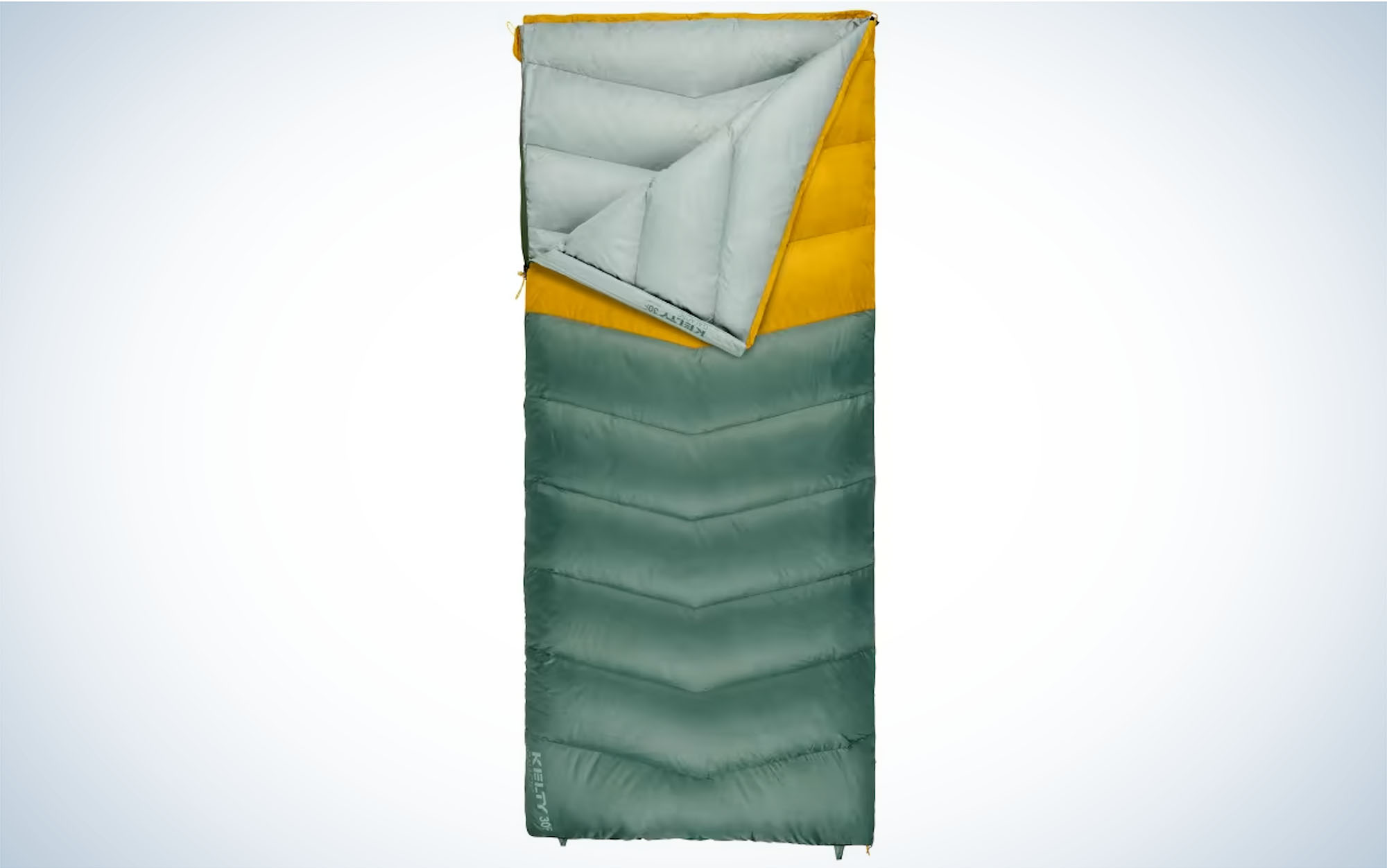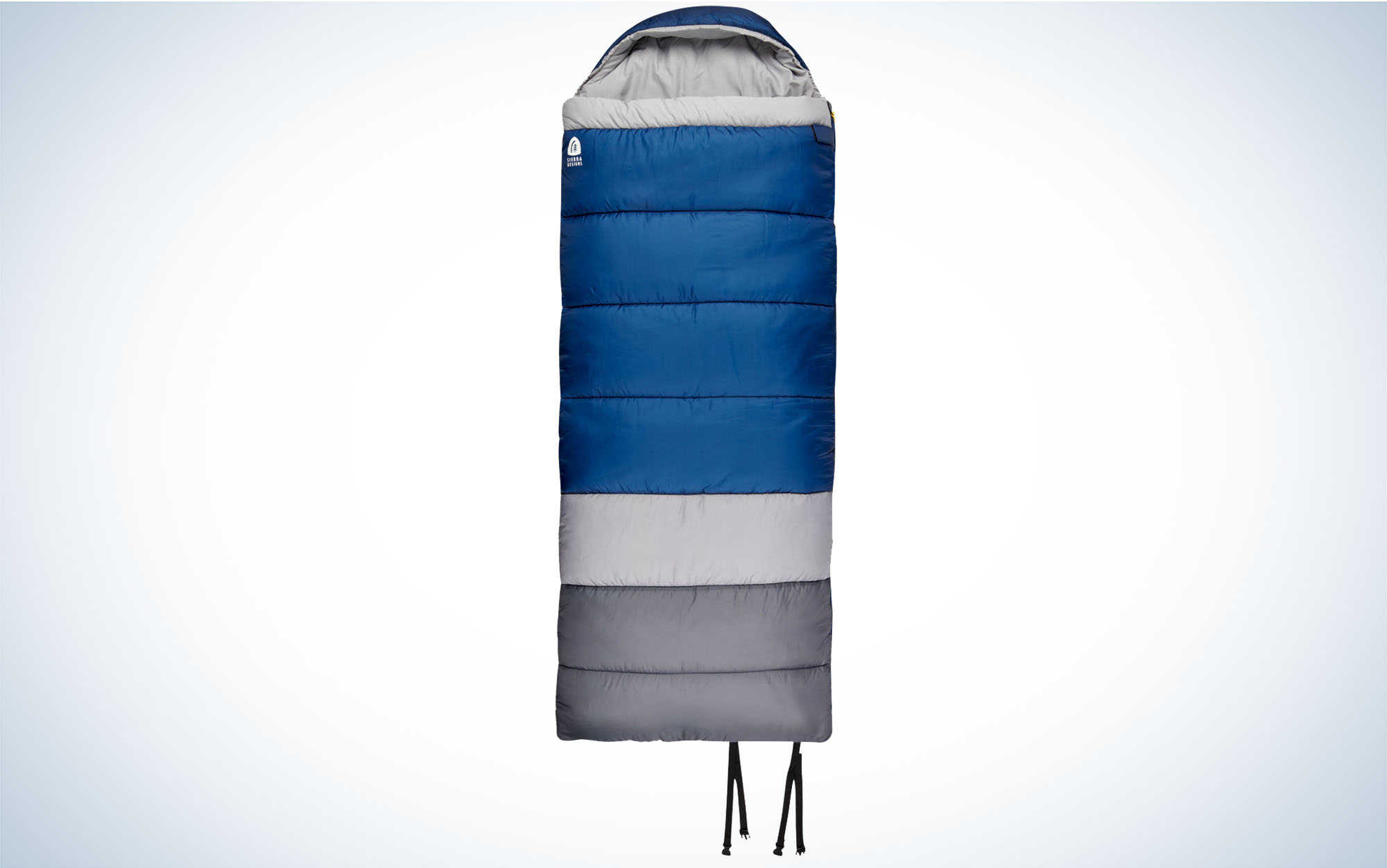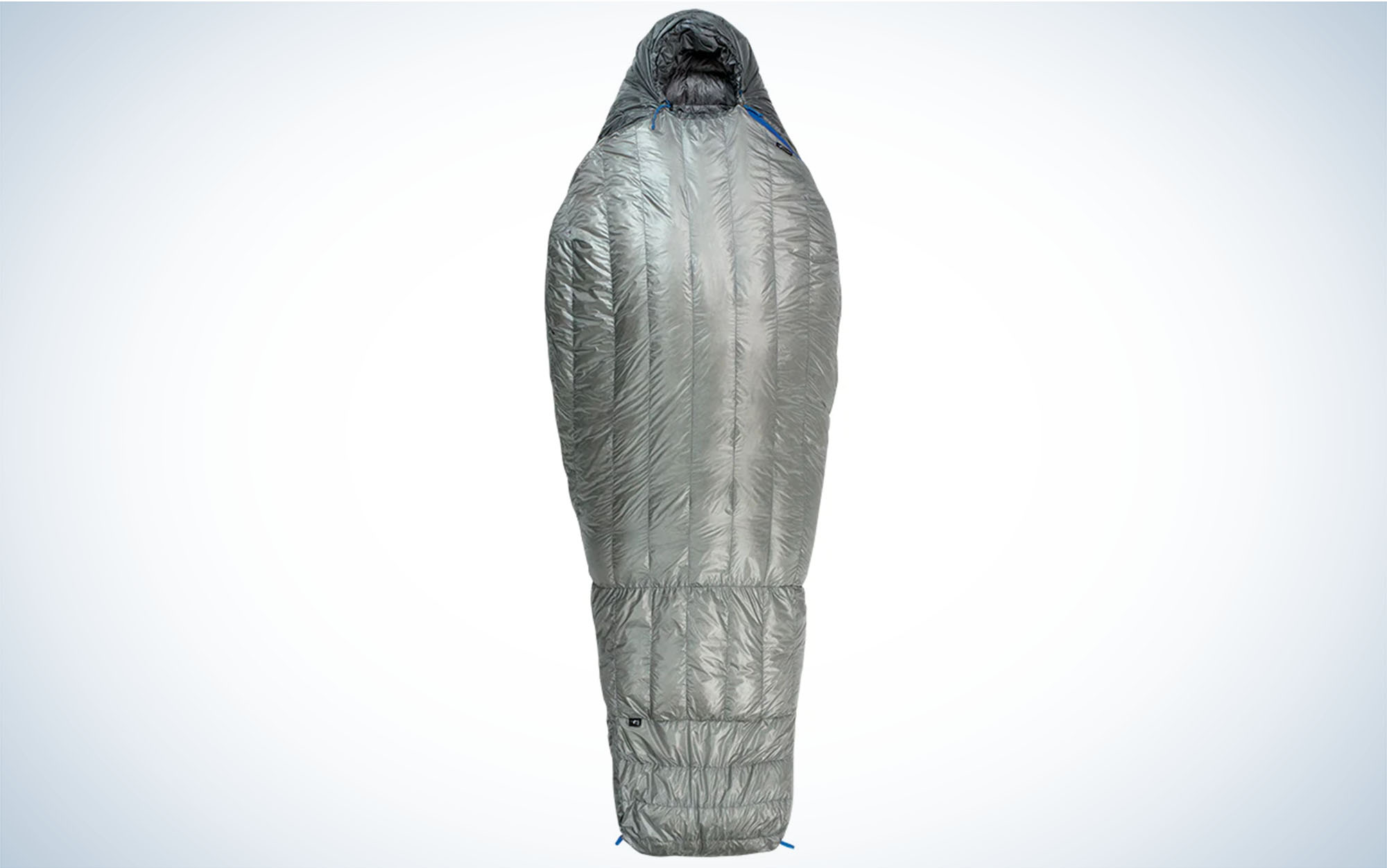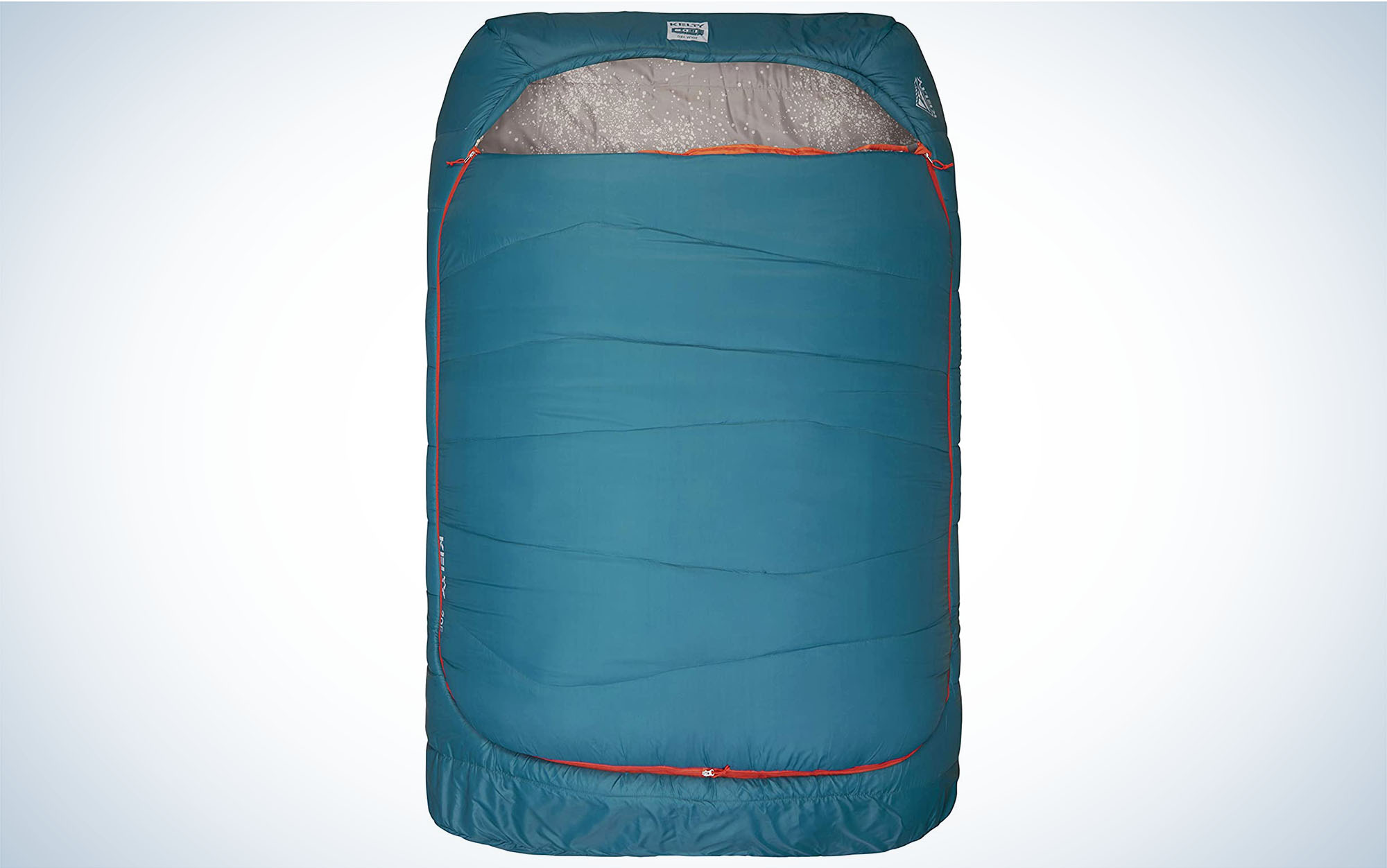We may earn revenue from the products available on this page and participate in affiliate programs. Learn More ›
Published Feb 15, 2023 11:00 AM
No adventure packing list is complete without one of the best sleeping bags for camping. But whether you are choosing one bag for an off-trail shoulder season hunt or outfitting the entire family for the first time, it’s important that you choose the right bag for your conditions and budget before you head deep into the woods. To help you choose, we took a look at some of the best sleeping bags for camping from top outdoor manufacturers.
| Sleeping Bag | Price | Temperature | Materials | Width | Length |
| Sierra Designs Boswell | $ | 20F and 35F | Polyester shell, synthetic fill | 34 inches | 84 inches |
| Klymit Wild Aspen Rectangle | $ | 20F | Polyester shell, synthetic fill | 34 inches | 74 inches |
| Kelty Galactic | $$ | 30F | Polyester shell, 550fp duck down fill | 34 inches | 76 inches |
| Kelty Tru Comfort Doublewide | $$ | 20F | Polyester shell, synthetic fill | 64 inches | 84 inches |
| Marmot Idlewild | $ | 30F | Polyester, synthetic fill | 34 inches | 82 inches |
| Stone Glacier Chilkoot | $$$$ | 0F and 15F | Pertex shell, 850fp goose down fill | 32 inches | 77 inches |
Testing the Best Sleeping Bags for Camping
I’ve been camping and backpacking for decades, and have spent my fair share of nights uncomfortably cold in a too-thin synthetic sleeping bag. Conversely, I’ve also crawled out of my bag entirely after waking up overheated and sweaty. I used that knowledge to call in and assess sleeping bags from some of the biggest names, including Kelty, Marmot, Stone Glacier, Klymit, and Sierra Designs. Several of the sleeping bags in this review were selected in part for their affordable price point, specifically for families buying bags for multiple people at the same time.
Because more than one of the sleeping bags in my test did not have ISO certification, I also tested their ability to trap warmth in adverse conditions. To do this, I took the sleeping bags out into mid-30s temperatures—the highest rating assigned to any of the sleeping bags I called in. To keep conditions consistent, I laid the sleeping bags out directly on the ground, without a sleeping pad (not recommended for actual use in the field) and tossed one of the best hand warmers inside. I then tested the comparative warmth of each sleeping bag to ensure that the 20 degree bags were warmer than the 30 degree bags. In general, add 20 degrees to the limit rating of each bag if you want to get any sleep in it, unless you run exceptionally warm. (See the temperature rating section of How to Choose a Sleeping Bag for more information.)
In addition to looking at how warm each sleeping bag was, I also looked at care and storage, how the materials felt, and other features like side zips, drawcords, and internal pockets.
The Best Sleeping Bags for Camping: Reviews & Recommendations
Best Overall: Klymit Wild Aspen Rectangle
Key Features
- Rated to 20 degrees; OL recommends this for temps as low as 40 degrees
- Material: Polyester shell, synthetic fill
- Width: 34 inches
- Length: 74 inches
- Packed Size: 20 inches x 8.5 inches
- Also available as a mummy bag
Pros
- Small packed size
- Affordably priced
- Warm enough for shoulder season camping
Cons
At first glance, the Klymit Wild Aspen Rectangle might remind you of the sleeping bag you had as a kid, but don’t be fooled. This one has important upgrades to make it camping ready. It uses a high-quality synthetic fill that provides an impressive amount of insulation—especially given its relatively svelte packed size (which can become even slimmer with some strategic tugs on the stuff sack’s compression straps). And it manages all that while still being affordably priced. If you’re looking to outfit the family with sleeping bags before next summer’s adventures, this is a great place to start.
My only complaint with the Klymit Wild Aspen Rectangle is that, unlike the mummy versions of the same bag, the rectangular version does not come with a hood option.
Best for Summer: Kelty Galactic
Key Features
- Rated to 30 degrees; OL recommends this for temps as low as 50 degrees
- Material: Polyester shell, 550fp duck down fill
- Width: 34 inches
- Length: 76 inches
- Packed Size: 15 inches x 7.5 inches
Pros
- Very small packed size
- Light enough to take backpacking
Cons
- No hood
- Not available at warmer temperature ratings
If you’re looking to halve the amount of space your sleeping bag takes up in the back of your hatchback, then the Kelty Galactic is the pick for you. It had by far the smallest packed size of any sleeping bag for camping that I looked at. It manages that, while keeping its 30-degree limit temperature rating, by using duck down instead of synthetic insulation. Duck down is the wispy feathers closest to the duck’s body, which excel at trapping pockets of heat. But when compressed down, those pockets disappear entirely, allowing for the Galactic’s exceptionally small packed size. Duck down is also notably lightweight and, at 2 pounds, 10 ounces, the Galactic 30 is light enough to take backpacking in a pinch.
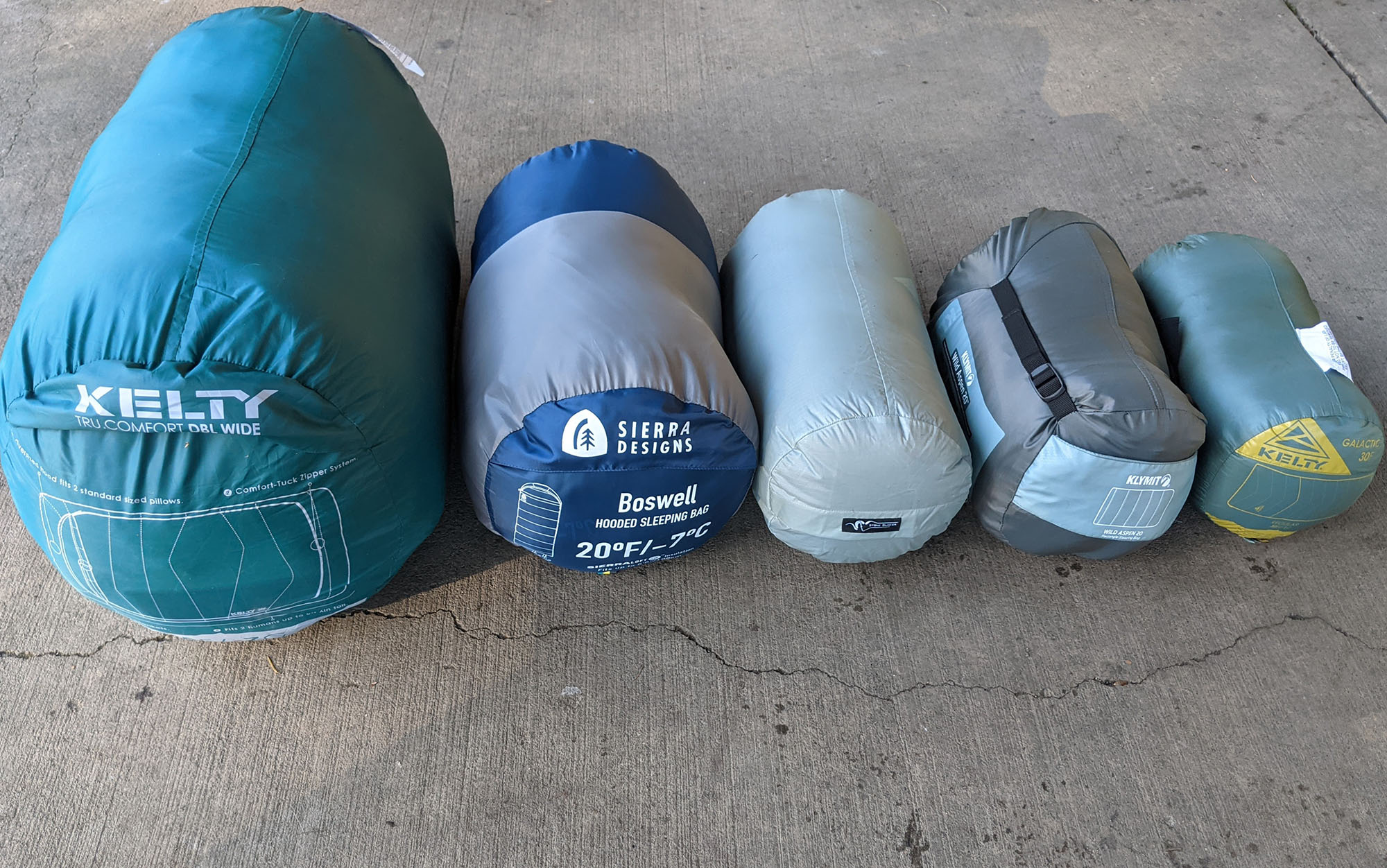
The downside of the Galactic 30 is that, for the 30F temperature rating, it’s fairly expensive, and it’s not available in any warmer temperatures.
Best Value: Sierra Designs Boswell
Key Features
- Rated to 20 degrees; OL recommends this for temps as low as 40 degrees
- Material: Polyester shell, synthetic fill
- Width: 34 inches
- Length: 84 inches
- Packed Size: 20 inches x 10 inches
- Also available as a 35-degree bag
Pros
- Very affordably priced
- Comes with a hood and double zip
Cons
The Sierra Designs Boswell was by far the best value of any sleeping bag I looked at, providing an impressive amount of insulation at a very low price point. The downside is that since it’s using a comparatively lower quality insulation, it has to use a bunch of it to achieve the same temperature insulation as other sleeping bags. Buying one each for a family of four might take up more space in your family’s SUV than you have to spare.
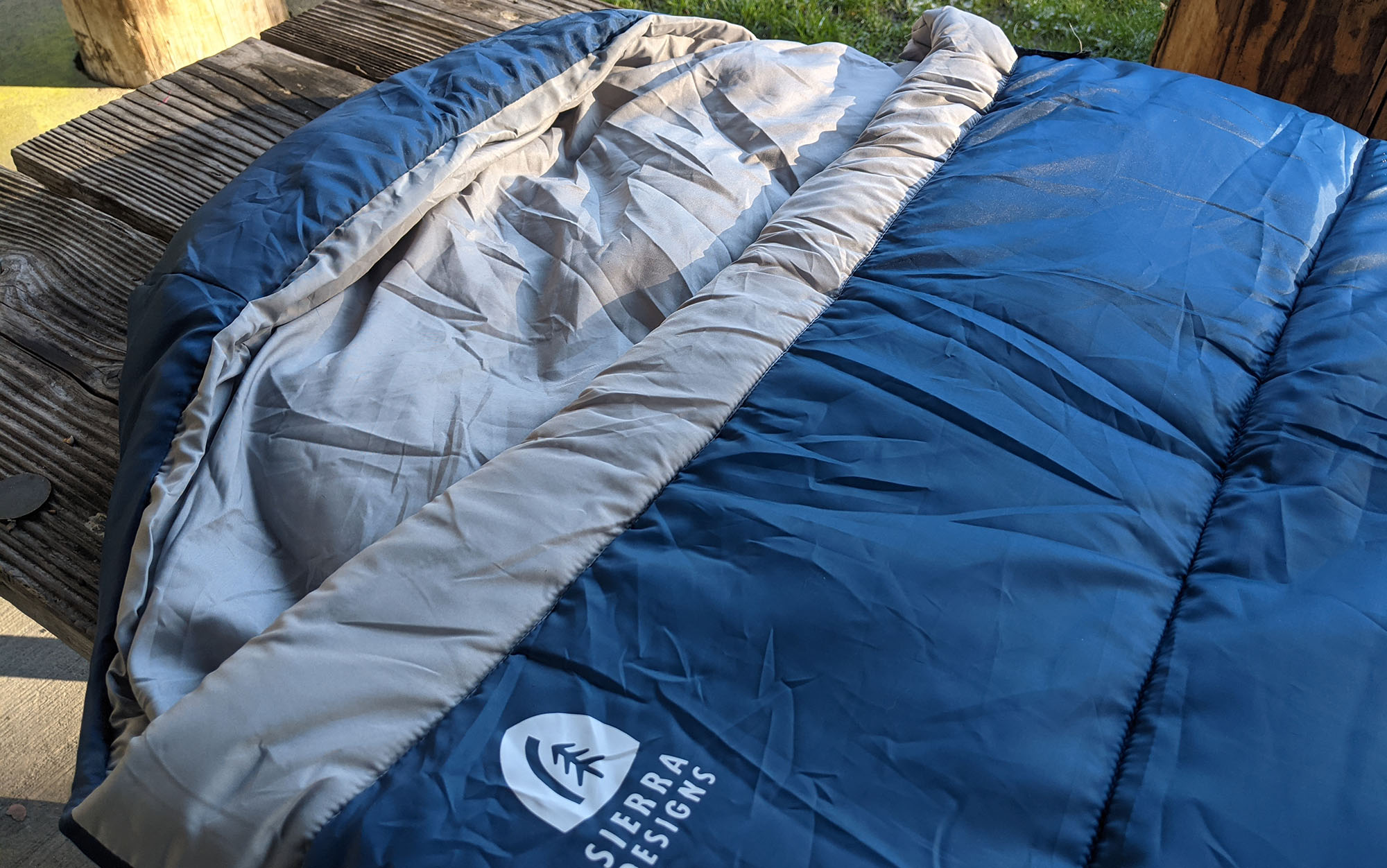
The Boswell also had a number of details that make for a comfortable sleeping experience, including a hood and a dual-direction zipper, which gives you a lot of flexibility for creating a warmer or cooler sleeping experience depending on the outside air temperature.
I also liked that it included the classic elastic loops on the bottom that can be used to hold the bag together without the stuff sack—handy in case it goes missing after a long week in the woods.
Best for Cold Weather: Stone Glacier Chilkoot
Key Features
- Rated to 0 degrees; OL recommends this for temps as low as 20 degrees
- Material: Pertex shell, 850fp goose down fill
- Width: 32 inches
- Length: fits individuals up to 77 inches
- Packed Size: 8.5 inches x 17.5 inches
- Also available as a 15 degree bag
Pros
- Extremely warm
- Small packed size
Cons
- Expensive
- Possibly too warm
If you’ve tried seemingly everything there is—mummy bags, down bags, double bags—and you’re still cold, I’ve got a few ideas for you. The first is to upgrade your sleeping pad: More often than not, it’s the cold of the ground that’s sucking all of the warmth out of your bag rather than the ambient air. The next is to pull out all the stops: high-quality down and lots of it, a best-in-class hood and neck guard, and a baffling design that keeps the warmth well-distributed across the bag.
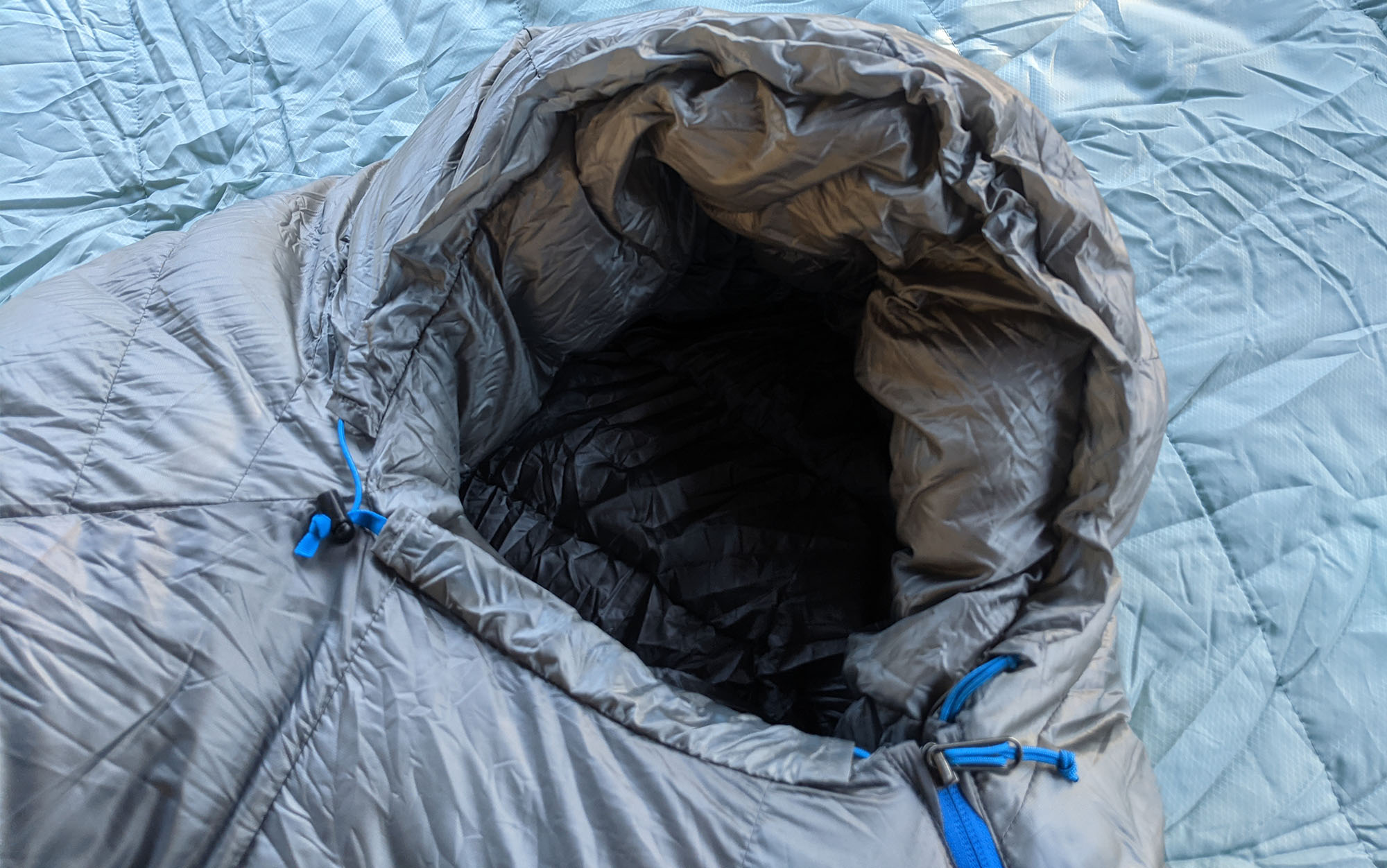
The Stone Glacier Chilkoot has all this, and stuffs down smaller than all but one of the sleeping bags in my test. That’s because even though it’s using almost two pounds of down, it’s using such a high quality (850fp) that those tiny feathers compress to just about nothing when packed away.
Best for Couples: Kelty Tru Comfort Doublewide
Key Features
- Rated to 20 degrees; OL recommends this for temps as low as 40 degrees
- Material: Polyester shell, synthetic fill
- Width: 64 inches
- Length: 84 inches
- Packed Size: 15 inches x 23 inches
Pros
- Allows for hot- and cold-blooded couples to share the same bag
- Hood can double to hold a pillow in place
- Versatile enough to handle a wide range of temperatures
Cons
For every reason you might want to zip up your sleeping bag with your partner—the warmth, the space-savings, the desire to not sleep like you’re in a 1950s sitcom—there is a reason this is a terrible idea. The cramped quarters. The cold drafts when they get out for a midnight bathroom break. And the inevitable disagreement about how warm of a sleeping bag you need to get.
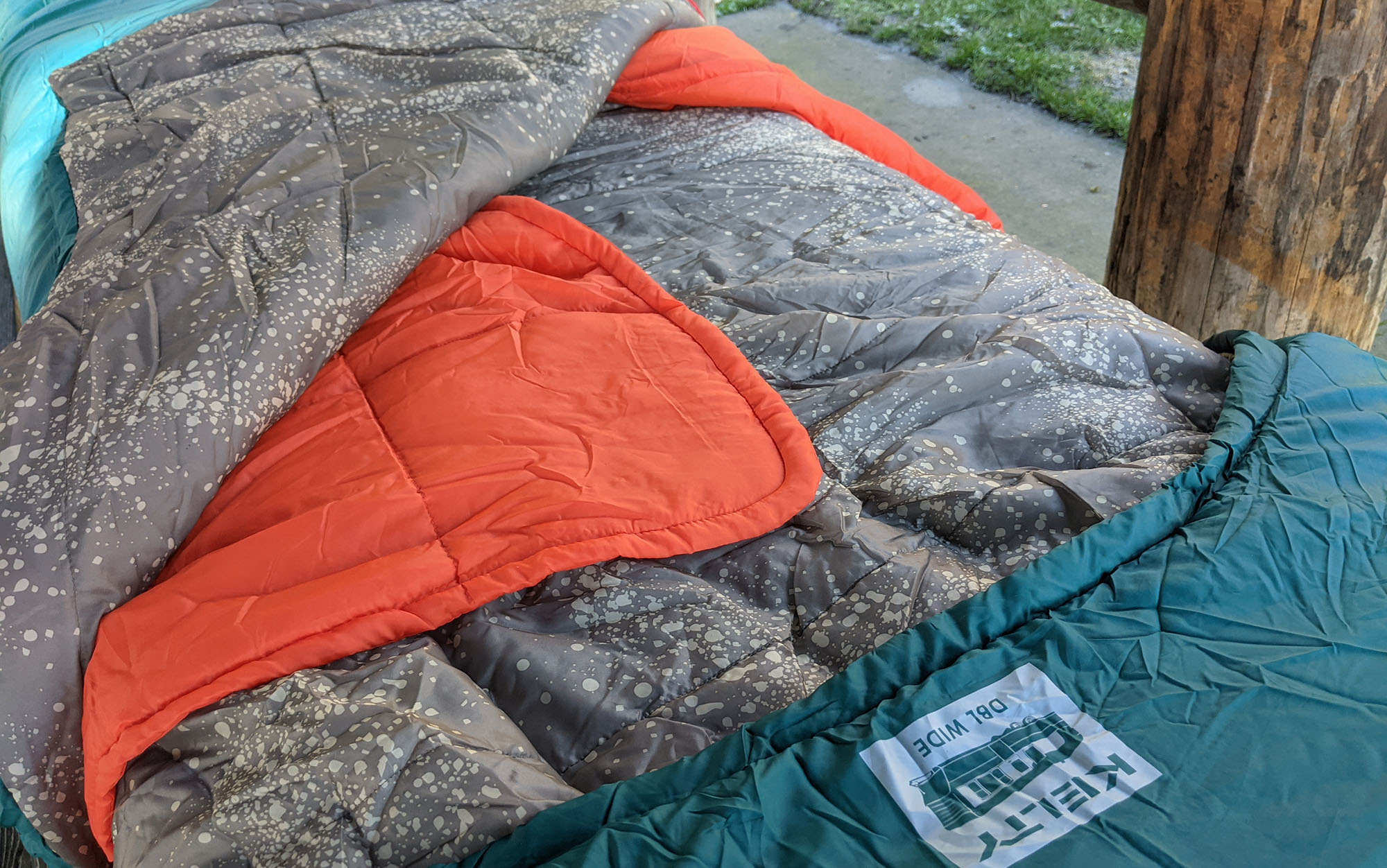
The Kelty Tru Comfort Doublewide helps resolve at least some of the inevitable disagreements with layering options on the inside. Where many sleeping bags have only a single temperature control, it’s on or it’s off, the Tru Comfort has two layers, a thin layer on the inner side of the sleeping bag for when the weather is exceptionally hot, which can be added to the main layer of the bag for when it’s exceptionally cold. And since you are inevitably going to disagree about what constitutes exceptionally hot and exceptionally cold, the thin layer is divided into two sections to make it easy to add on or kick off. The outer layer can also be unzipped fully on each side.
How to Choose the Best Sleeping Bags for Camping
Temperature Rating
The good news is that there is an official, scientific way to measure the warmth of a sleeping bag. The bad news is that most of the sleeping bags that campers use are not evaluated using this standard. Also, a lot of them are using the “you’ll live” (limit) temperature rating for the sleeping bag, as opposed to the “you’ll be warm” (comfort) rating, as the sleeping bag’s retail name. You are also an individual, so what’s warm for you and what’s warm for me is going to be inherently subjective.
However, there are methods you can use to choose the best sleeping bag for your purpose. You’ll know if the sleeping bag you’re thinking about purchasing was evaluated using scientific measurements because it will refer to either an EN or ISO rating. These ratings are verified by third parties using a heat-producing mannequin with temperature sensors placed inside of a climate controlled room on top of a 4.8-R rated sleeping pad. I’m paraphrasing here, but you get the idea of what an intense process this is. One reason some sleeping bags for camping aren’t evaluated using the ISO or EN scale is that it requires the sleeping bag to have a hood. The 4.8-R rating on the sleeping pad isn’t a minor detail, either, if you are consistently cold in your sleeping bag, it’s possible that you need to look for a higher R-rating on one of the best sleeping pads for backpacking or the best camping mattresses for couples.
EN and ISO ratings look at the “comfort” temperature, a “lower limit” or “transition” temperature, and a “risk” temperature. The comfort number is what it sounds like—this is the temperature at which you’re the most likely to actually be comfortable. The “lower limit” or “transition” temperature is when you will start to feel uncomfortable—you’re not shivering necessarily, but you’re not sleeping well either. The “risk” temperature is the temperature at which you are in danger of hypothermia.
When there isn’t an ISO rating, most sleeping bag manufacturers will typically provide just the limit rating, but they don’t always specify this, which can be confusing for consumers. In general, it’s best not to assume that a sleeping bag rated to 30 degrees is going to keep you warm to 30 degrees—generally it will be closer to 40 degrees. Don’t have a sleeping pad with at least a 4 R rating? Add on another 10 degrees. Run cold naturally? You get the idea.
If you’re planning to only camp during the dog days or summer (or you run hot as a furnace), then you’ll be OK with a 30- or 35-degree bag. If you expect the nights to dip as low as fifty degrees, go with a 20-degree bag or lower. Anything colder than that and you’ll want to be sure you’re purchasing a sleeping bag with ISO credentials and have a properly R-rated sleeping pad.
Read more: How to Choose a Sleeping Bag
Packed Size
Generally, more expensive fill will pack down to a smaller size than less expensive fill. For a single person or even a couple, larger sleeping bags won’t be an issue, but families may find that excessively large sleeping bags are taking up more space in their car than they’d like. If you’re looking to keep the packed size of your sleeping bag at a minimum, look for sleeping bags made from duck or goose down. Even lower fill power (500 to 600fp) will pack down significantly smaller than synthetic fill.
Shape
Most sleeping bags for camping are in the classic rectangular shape—what you probably remember from sleepovers as a kid. It has plenty of room for restless kids to toss and turn while they sleep, and it’s got plenty of space for you to do the same. The downside to rectangular sleeping bags is that they require more fill to achieve the same level of warmth as both mummy and semi-rectangular sleeping bags, given the extra air and space inside for the bag that needs to be heated, and the potential for drafts to sneak in at the top of the bag. In fact, rectangular bags are so bad at keeping heat in that most aren’t made to handle wintertime temps.
The other classic sleeping bag shape is referred to as “mummy” because you’ll need to arrange your body just-so inside of them to fit. While mummy sleeping bags are exceptionally good at maximizing warmth for weight, their shape makes them fairly uncomfortable for all but the most dedicated back sleepers. For this reason, many sleeping bag manufacturers also make a mashup of the classic rectangular sleeping bag with the mummy design: semi-rectangular sleeping bags. These taper some between the shoulders and the footbox, but not enough to prevent you from rolling over. They usually incorporate a hood, and can typically be cinched up around the neck to prevent a draft from creeping in. They also come at temperature ratings that are appropriate for both shoulder season and winter activities.
Fill
One of the most important distinctions between sleeping bags is whether they use synthetic or down fill. Most sleeping bags for camping get their warmth from synthetic (typically polyester) fill—again, think of the bag you used for sleepovers as a kid. Synthetic-fill sleeping bags tend to be heavier, lower cost, and better able to retain heat when wet. Most high-end bags, however, are filled with soft, fluffy feathers, found under the tough exterior feathers of ducks or geese. Down-filled sleeping bags are often more expensive, lighter, and warmer.
If you look at a down feather (they tend to poke their way through sleeping bag fabric every so often), you’ll see that it’s made up of innumerable wisps connected to a short shaft. The lack of structure to these feathers creates small air pockets, which trap heat from your body and insulate it from the cold outside air. Down-feather quality is measured by fill power (fp), or how much down it takes to fill one cubic inch of space. For instance, one ounce of 550fp down will fill about 9 liters, while one ounce of 900fp will fill almost 15 liters.
In sleeping bags, using down with high fill power can result in significant weight savings. The Achilles heel of down feathers has always been moisture—when down gets wet, the pockets of air disappear, eliminating virtually all of its insulating properties. In recent years, sleeping-bag manufacturers have started using down feathers treated with a water-resistant coating, sometimes referred to as DownTek, but there are several different names. While a soaking wet sleeping bag using DownTek is still going to make for an uncomfortable evening in the backcountry, water-resistant down does reduce the heat loss caused by overnight condensation inside your tent. When purchasing a down sleeping bag, I recommend looking for a bag that is RDS (Responsible Down Standard) certified, which helps ensure that no geese or ducks were unnecessarily harmed (such as live plucking).
While the sleeping bags of slumber parties are a good example of synthetic fill, high-end synthetic fill mimics the qualities of down, using short filaments that create pockets to trap your body heat. Further, synthetic fill retains heat while wet without the need for additional treatment. The highest quality synthetic fills can approach the insulation-to-weight ratio of 650fp down, but these synthetics also approach the cost of lower quality down. In some instances, sleeping bags will incorporate both down and synthetic fills to balance the pros and cons of both.
Shell and Lining Materials
Holding in all that cozy fill is the shell (outside of your bag) and lining (inside of your bag, closest to your body). These are typically made out of either nylon or polyester, which are both reasonably comfortable and reasonably durable. High-quality sleeping bags will also tell you the thickness of the material (rated in denier (D)). Thicker materials weigh more but offer more durability, and thinner materials need some TLC, but contribute to an overall lighter weight. Generally, 65D is a fairly robust material while 320D or lower would be considered lightweight. Sometimes you’ll also see that the shell or lining is “ripstop,” which is a type of weave that prevents the material from ripping further if it gets a tear (useful, if you plan to repair your gear). Sometimes the lining is advertised as “taffeta,” which is essentially a fancy way of saying the material is meant to be soft (results may vary). Sometimes the shell will also have a durable water repellent (DWR) coating, which can be useful if you expect to experience condensation inside your tent.
Hood
You lose a significant chunk of body heat out of your head, so having a hood on your sleeping bag (typically stuffed with the same fill as the rest of the bag) makes a lot of sense. Hoods are most common on mummy bags, although they also appear on many models of semi-rectangular bags and some rectangular sleeping bags.
FAQs
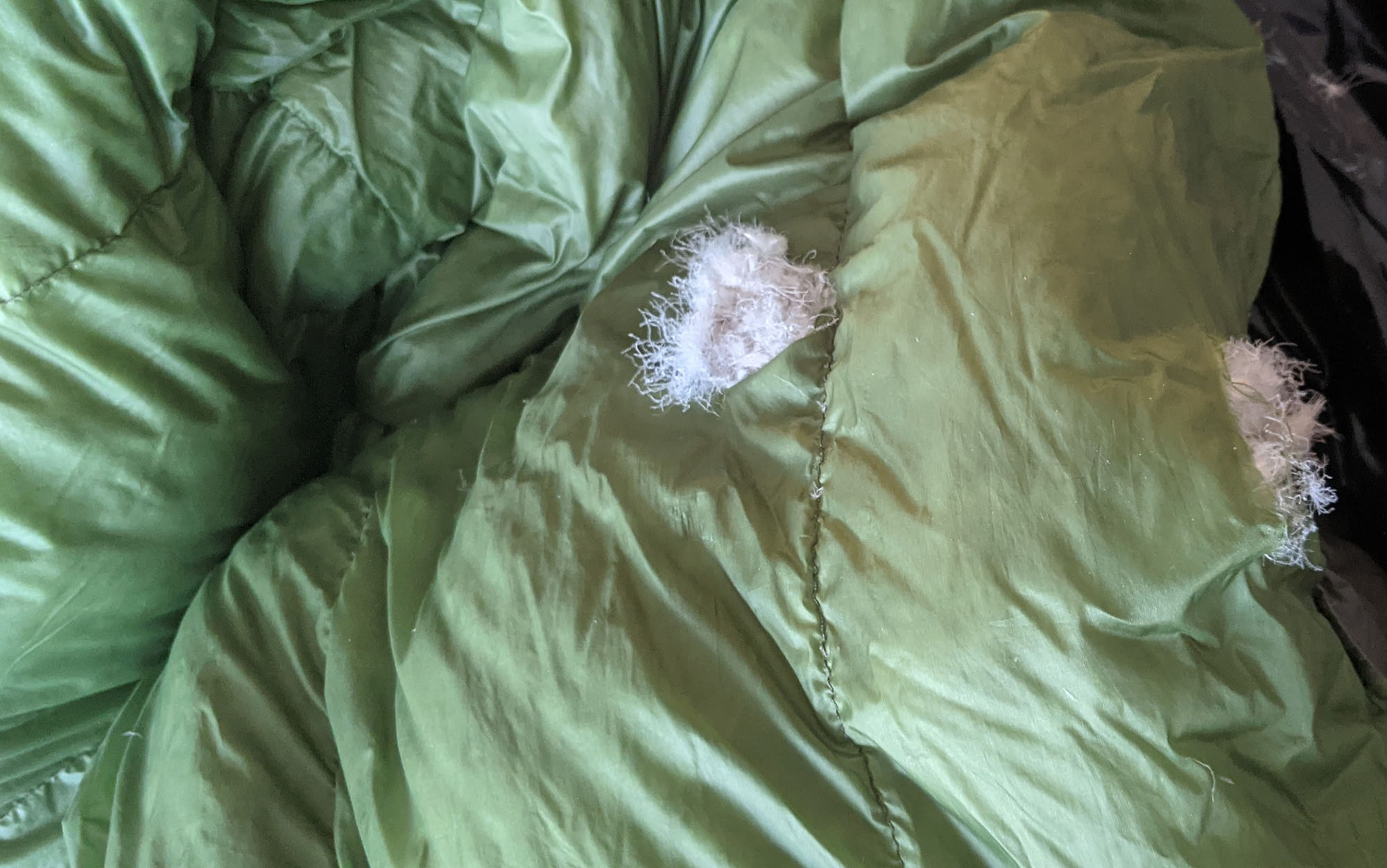
Q: How do I clean my sleeping bag for camping?
Sleeping bags for camping can be machine washed, however you must find one that is large enough to hold your sleeping bag and it cannot be a top-load washer with a center agitator. Top-load washers can damage the fabric of your sleeping bag.
Typically, the washing instructions for sleeping bags will recommend that you use cold water only on the gentle cycle, and to dry the sleeping bag on the lowest possible settings. Using a down detergent can help to extend the life (and improve the loft) of a down sleeping bag. Tossing a tennis ball into the dryer can also help to break up clumps, allowing the sleeping bag to regain its full loft sooner.
Q: Are tighter sleeping bags warmer?
Tighter sleeping bags need less fill to achieve the same warmth than looser sleeping bags but are not inherently warmer otherwise. One of the warmest sleeping bags I own is a custom-made rectangular sleeping bag stuffed to the gills with down. If warmth is your top consideration in choosing a sleeping bag, it’s a good idea to choose one that has been ISO-rated. Look for the comfort temperature rating (as opposed to the limit temperature rating) and add an extra 10 degrees, to be on the safe side. Next, make sure you are choosing a sleeping pad with an appropriate R rating. Finally, if your sleeping bag does not come with a hood, choose a hat to wear with it.
Q: What is the best material for a sleeping bag?
While the best material for sleeping bags is goose or duck down, synthetic fills are plenty warm enough for summertime temps. Which one is best for you depends on your budget, and how much space you have in your car (down sleeping bags will pack down significantly smaller for the same warmth as synthetic fills).
Q: What is the difference between a 3- and 4-season sleeping bag?
Despite their name, three season sleeping bags are primarily used for summertime temperatures (with some overlap for hot-blooded individuals into the edges of the shoulder seasons) while 4-season sleeping bags are typically meant for shoulder season and wintertime temperatures.
Why Trust Outdoor Life?
Since 1898, OL has been a leading authority in testing and reviewing hunting gear, fishing tackle, guns and shooting equipment, and much more. We have more than a century-long history of evaluating products, and we’re now bringing that expertise to online reviews. Our editors are experienced outdoorsmen and women, and most importantly, we’re trained journalists. We prioritize field testing and objective data when reviewing products. We conduct interviews with gear manufacturers and engineers as well as outdoor experts so that our readers have an understanding of how and why a product works—or doesn’t.
Advertising does not influence our gear reviews and it never will. While we always focus our coverage on standout products—because we want our readers to be aware of the latest and greatest gear—we also cover the flaws and quirks of any given product.
Final Thoughts
Nothing can ruin a camping trip faster than a too-cold sleeping bag. Our picks are from reputable brands with a long history of making quality products. Choose the model that best fits your season, destination, and—most importantly—your individual warmth needs. If you feel that even the rectangular sleeping bag shape is too restrictive, consider one of the best backpacking quilts instead.

